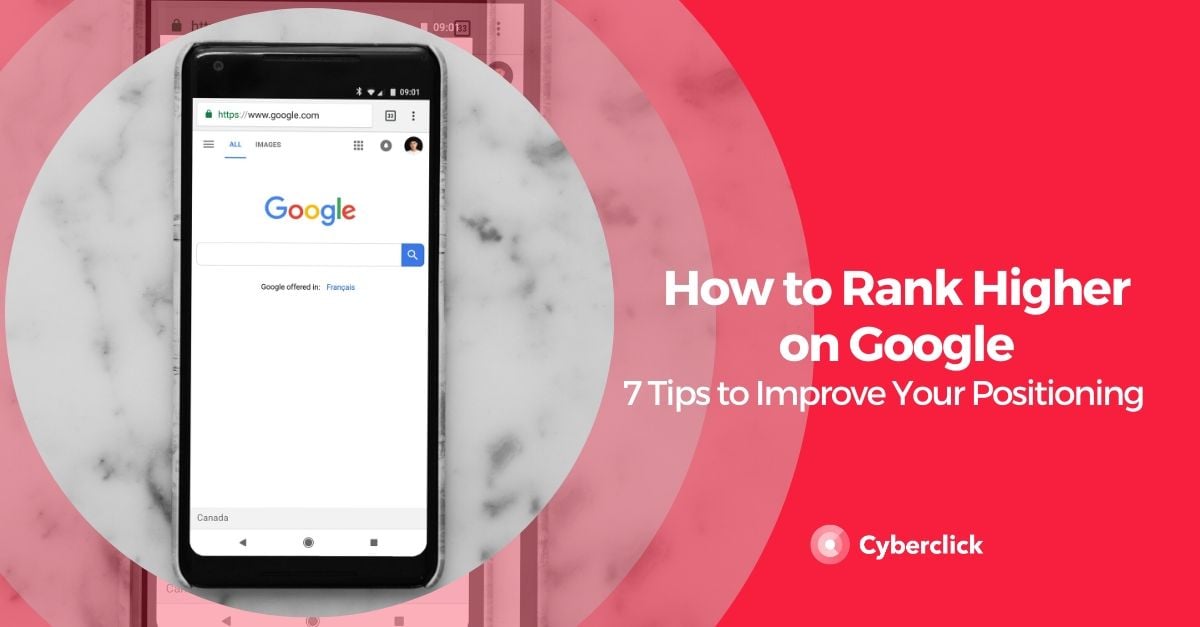By Shanon Roberts, on 31 March 2020
Ranking on Google is a mix of both science and art. On the one hand, you must take into account practical SEO tactics, like keyword research and technical SEO, while also providing valuable, entertaining content that people want to click on.
So, how do you achieve this balance?
In this article, we’ll review several different techniques and considerations that will help you improve your SEO ranking on Google.

How to Rank Higher on Google: 7 Tips
1. Content Relevance
You’ve seen this phrase is just about every single SEO article out there: “Content is king.”
There’s a reason it’s repeated so often.
Before you start analyzing any other aspect of your SEO strategy you need to take a good look at your content strategy. The first step of improving securing a higher search engine ranking is to create original, high-quality content.
That is to say, develop content that serves a purpose and fully answers a question a user may have. Google only wants to show its searchers content that is authoritative, correct, and polished.
Remember, you cannot trick Google. The days of sticking the same keywords into your blog over and over again are gone. It is important to invest time in making relevant content that users will be able to get value out of.
Keyword research (which we’ll dive into deeper below), images, and videos are all good sources for improving the quality of your content. Images like infographics or relevant photos can break up the monotony of all the text on a page. Similarly, videos add value to your written content while also keeping people on your page longer (which Google will pay attention to.)
2. Keywords
It should come as no surprise that keywords are a crucial aspect of ranking higher on Google. But are targeting the right keywords?
When conducting your keyword research, you have to pay attention to key factors:
- Search volume
- Keyword difficulty
If you are only targeting keywords with the highest search volume than you are never going to be able to properly improve your SEO ranking. Although the high numbers may be tempting, in reality it is incredibly difficult to rank for generic terms and topics like “interior design.”
Instead, focus on long-tail keywords and keywords with lower search volumes.
Longtail keywords are typically keywords that are more specific and use a few more words. For example, if the main keyword is “interior design”, a long-tail keyword would be “small space interior design.” While this keyword has a significantly lower search volume, it also means that it is easier to position for this word.
While it may seem counter-intuitive, this a solid method for bringing more qualified users into your website, and gives you a way to narrow down your content and rank easier.
That is to say, don’t avoid high search volume keywords. But, don’t place all your eggs into that basket. You will likely naturally include them in your content anyways, which is still beneficial and important for Google to know what you’re talking about.
We’ve written an article about this topic to help you find the right words when conducting your keyword research. Tools like SEMrush and Google Keyword Planner are extremely beneficial for this.
3. Updating your Content
If you’ve already covered the basics, what else can you do to rank higher on Google? A good place to start is with the content you already have.
SEO is not evergreen. Keywords that may be well-positioned one month may not be the same six months down the road. And this can affect your page’s position in Google.
This is especially relevant if you’ve noticed that some of your most reliable pages have been receiving fewer views and clicks over time. Update that specific content to include new relevant keywords, new information, and refreshed sources.
This doesn’t mean you should update your blog from last week. Rather, set aside time every few months to review all of your older content and see what can be improved and what can be updated to keep up with the current landscape. This is mostly relevant for blogs with a large inventory and a lot of content.
4. Pillar Pages
Do you have pillar pages on your website? This inbound technique can really help boost your Google positioning because it established relevance and authority.
A pillar page is a webpage, separate from your blog, that provide a “big-picture” explanation a certain topic or concept that you write about frequently. For example, on our website, we have pillar pages dedicated to Inbound Marketing, Marketing, and Advertising. These pages then link to other pages that provide a more detailed explanation of the different aspects of the larger topic. For example, Content for Inbound Marketing.
We then include links, when relevant, to these pillar pages in our blog content. These pillar pages tell Google that we are experts on this subject and that we frequently write about this concept.
Pillar pages also organize your website internally, making it easier for both Google to understand what you write about and easier for your readers to find more content they may be interested in.
5. Link Building
Unfortunately, the saying “If you build it, they will come” does not apply to SEO. Not only do you have to build it, but you have to promote it too.
Link building means other websites link directly to your content. Although cumbersome, you can’t ignore link building in your SEO strategy.
Link building is important for ranking on Google because te search engine is able to trust your website more if they determine that others trust you enough to link to.
So how can you build your backlinks?
First, start by looking at which websites link to your competition’s content. Try to determine why they are linking to them and then create content that is even better. You can then offer the piece of content to the website and see if they will consider changing the links to yours.
You can also write content and offer it to different relevant websites with a good domain authority. Instead of choosing random websites, make sure you pick websites that have content that can be tied into your own. For example, a running shoe company writing about endurance during marathon training could fit really well with a company who sells energy health food, like running jellybeans.
Writing guest blog posts is also another good way to build links to your content. Just remember, it must provide value and be on a good website, preferably one that has even more authority than your own.
6. Technical SEO
Another easily overlooked method for improving your position on Google is Technical SEO. Think of this as behind the scenes tactics you can use to help your webpage.
Some important considerations for technical SEO include:
- Website load time
- Mobile Friendliness
- Website speed
- Alt Text
- Compressed Images
- Properly using H1, H2, and H3
- Meta Description
- Internal Linking Strategy
Google provides a very in-depth guide of all the different things to consider for technical SEO.
These are all important considerations that you should test and look into because they could be holding you back.
A fast loading website will aid you in more ways than one. First, if your website takes too long to load you risk having people leaving before they even have a chance to look at the content you spent so much time on. Similarly, Google will prioritize those that load quicker, especially for mobile. Compressed images will help your speed times.
Remember to include Alt Text in every one of your images on your website. Remember, Google’s crawlers can’t see images, so they rely on alt text to determine what the image is about. Your alt text should include the keywords you’re trying to rank for on the specific page they are on.
And finally, remember to include your keywords in your H1, H2, and H3 headers, blog title, URL, and meta description. And don’t forget to include an internal linking strategy within your content. This will keep readers on your website longer and prove to Google you are an expert in this field.
7. SERPs, Snippets, and Results… Oh My!
When writing your content, try to write it in such a way that it increases its chances of being featured in a snippet or SERP.
Snippets and SERPs have changed the need for users to actually click into a link in order to get an answer to their search query. Instead, Google now displays the answers on the results page, meaning the user never has to actually enter your website.
This means that it is even more important to secure the top spot in Google, aka “position 0.”
Using proper H2 and H3s can help Google understand that you’ve just answered a question. Also, mimicking relevant keywords that asks for information can help, but remember to keep you content natural. Google knows when you are wording something strangely to just include the keyword. Like we said above, if it doesn’t provide value, Google won’t position it.
I hope with these seven tips that you will be able to improve your ranking on Google over time. Overall, if there is one thing you should take away from this article, your SEO strategy will benefit from solid, valuable content and paying attention to the little details.


